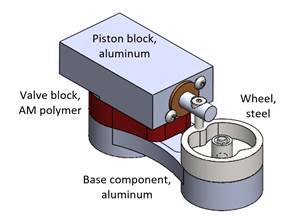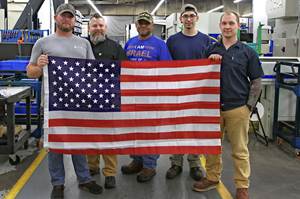Manufacturing's Future...Dependant On A Skilled Workforce
The strength of manufacturing’s future is dependent on the ability of all levels of the educational structure to respond to the needs of industry and develop and maintain a skilled workforce. The Society of Manufacturing Engineers (SME) is dedicated to advancing that process.
Share






The strength of manufacturing’s future is dependent on the ability of all levels of the educational structure to respond to the needs of industry and develop and maintain a skilled workforce. The Society of Manufacturing Engineers (SME) is dedicated to advancing that process.
To transform manufacturing education to better prepare today’s and tomorrow’s practitioners to meet the accelerated technical and business advancements of the 21st Century, SME and its Education Foundation (SME-EF) formed a joint endeavor called the Manufacturing Education Plan (MEP). Through this plan, SME recognizes there is a problem not only in filling the pipeline with individuals interested in manufacturing, but also in preparing students to graduate with the skills industry seeks and in providing necessary programming to meet this need. Additionally, there must be a commitment to career development for professionals to fulfill the need for lifelong learning.
The MEP comprises initiatives at three different levels: K-12; college, university and technical schools; and lifelong learning. Its goals are three-fold.
At the first level, the goal of the K-12 initiative is to stimulate interest in manufacturing, engineering and technology careers—to fill the pipeline with individuals interested in and knowledgeable of manufacturing.
In addition to our own programs—STEPS (Science Technology & Engineering Preview Summer Camp), SME Youth Summits and the RI/SME Student Robotic Challenge— we support other programs that fit our criteria. SME also offers a Web site, , to provide answers and guidance to enhance career development.
STEPS is the nation’s first initiative to attract girls and minorities into careers in manufacturing and technology. In this hands-on, tuition-free intervention program, girls ages 12 to 17 learn to design and manufacture their own remote control airplanes and learn how an internal combustion engine works. They manufacture all of its parts—from wings to the plastic canopy—while receiving first-hand knowledge of the manufacturing process.
Ìý
In 2000, the foundation launched the STEPS program in Minnesota in a technology-based outreach approach. SME-EF plans to reach 11 more states by 2004.
SME also uses its manufacturing expositions to bring first-hand knowledge of manufacturing careers to local high school and vocational students through its Student Summits. During these half-day educational programs, groups of high school and vocational school students tour the exposition, seeing hands-on technology demonstrations from select industry-leading companies.
The second level of the MEP, the colleges, universities and technical programs initiative, supports the creation and enhancement of manufacturing programs targeting industry-identified competency gaps. SME’s goal is to facilitate dialog between industry and academia to make sure manufacturing education programs deliver graduates who meet industry requirements. These requirements are closely monitored by SME, and the group works with the academic community for integration of these specifications into engineering programs.
The third initiative, lifelong learning, covers the ongoing commitment to career development for those individuals already in manufacturing and engineering. These programs include continuing education, career development tools, certification, technical resources and partnership development. The goal is to ensure that workers continue to have the skills necessary to help employers compete on a global basis.
SME is committed to the Manufacturing Education Plan and is serving the manufacturing community by opening doors for individuals interested in technology and supporting continuing education.
Related Content
How I Made It: Amy Skrzypczak, CNC Machinist, Westminster Tool
At just 28 years old, Amy Skrzypczak is already logging her ninth year as a CNC machinist. While during high school Skrzypczak may not have guessed that she’d soon be running an electrical discharge machining (EDM) department, after attending her local community college she found a home among the “misfits” at Westminster Tool. Today, she oversees the company’s wire EDM operations and feels grateful to have avoided more well-worn career paths.
Read MoreSolve Worker Shortages With ACE Workforce Development
The America’s Cutting Edge (ACE) program is addressing the current shortage in trained and available workers by offering no-cost online and in-person training opportunities in CNC machining and metrology.
Read MoreFinding Skilled Labor Through Partnerships and Benefits
To combat the skilled labor shortage, this Top Shops honoree turned to partnerships and unique benefits to attract talented workers.
Read MoreFinding the Right Tools for a Turning Shop
Xcelicut is a startup shop that has grown thanks to the right machines, cutting tools, grants and other resources.
Read MoreRead Next
AMRs Are Moving Into Manufacturing: 4 Considerations for Implementation
AMRs can provide a flexible, easy-to-use automation platform so long as manufacturers choose a suitable task and prepare their facilities.
Read MoreMachine Shop MBA
Making Chips and 91ÊÓƵÍøÕ¾ÎÛ are teaming up for a new podcast series called Machine Shop MBA—designed to help manufacturers measure their success against the industry’s best. Through the lens of the Top Shops benchmarking program, the series explores the KPIs that set high-performing shops apart, from machine utilization and first-pass yield to employee engagement and revenue per employee.
Read More

















